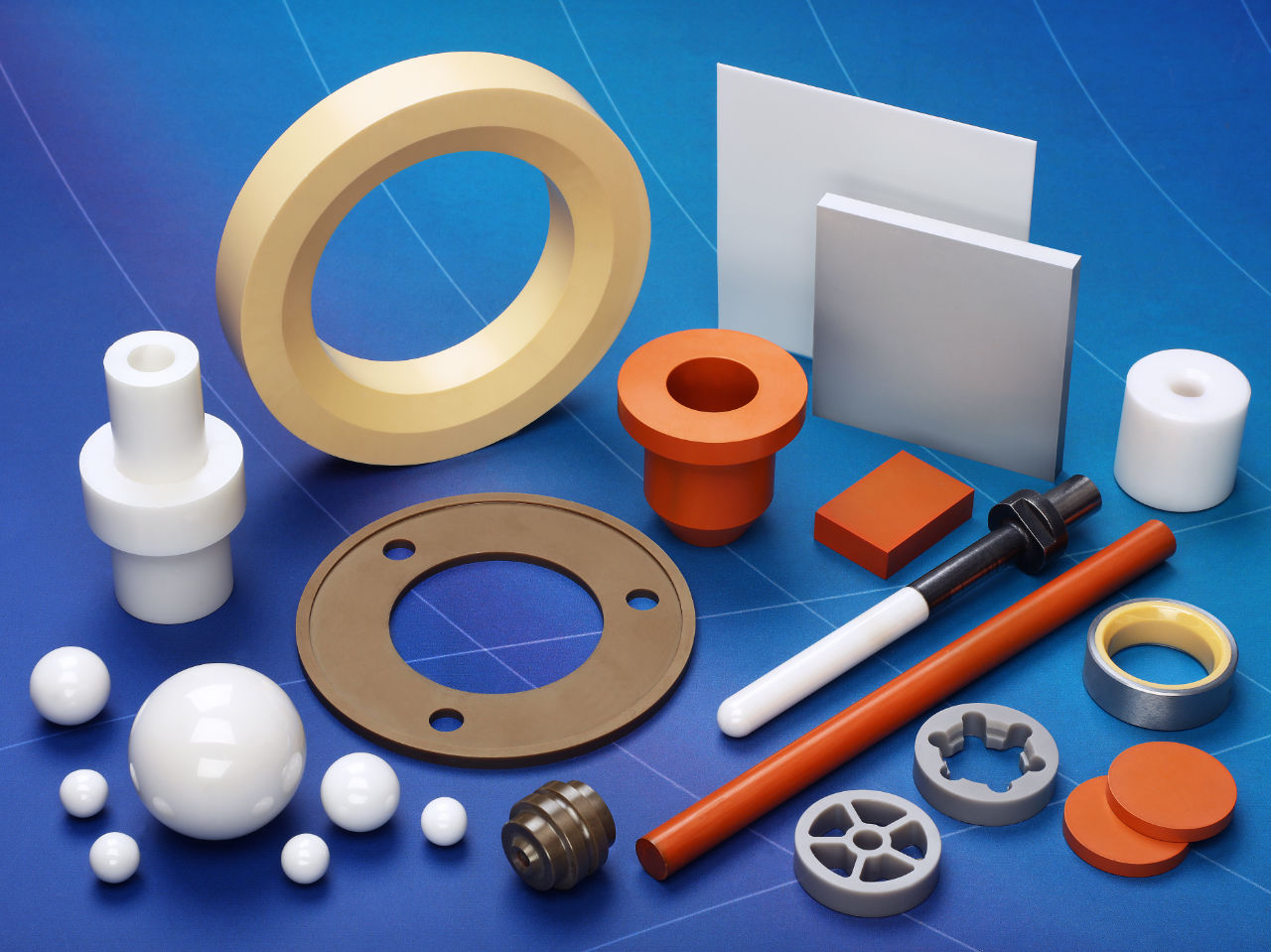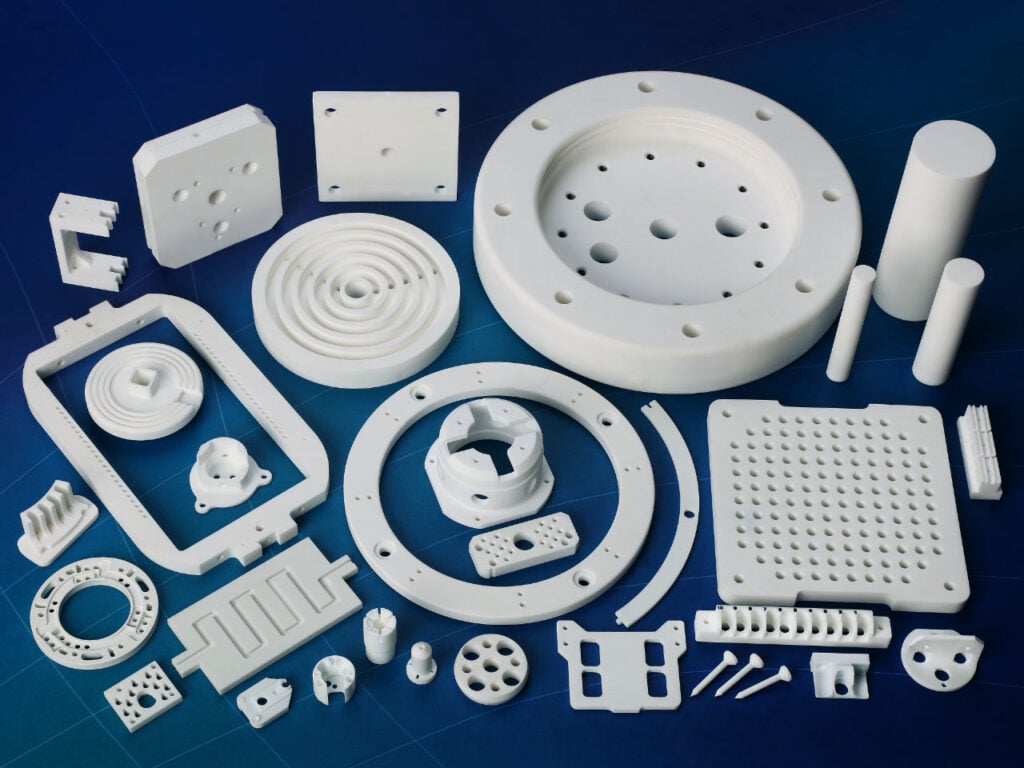Zirconia (ZrO2) – CeramaZirc™
Material Advantages
- Use temperatures up to 1000°C
- Low thermal conductivity
- Chemical inertness
- Resistance to molten metals
- Wear resistance
- High fracture toughness
- High hardness
Applications
- High pressure equipment ball valve balls and seats
- High density ball grinding media
- Rollers and guides for metal forming
- Thread and wire guides
- Metal extrusion dies
- Deep well down-hole valves and seats
- Powder compacting dies
- Pump seals and shaft bearings
- Oxygen sensors
- High temperature induction furnace susceptors
- Fuel cell membranes
Material Grades
There are several different methods used to produce Zirconia. Each method produces materials with slightly differing properties.
CeramaZirc Ultra Tough
CeramaZirc Ultra Tough is a advanced zirconia ceramic composite material based on partially stabilized zirconia and an enhanced crystal structure.
General Properties
- Use temperatures up to 1500°C
- Sintered to full density for a pore-free structure and competitive price
- No compromise between bending strength, hardness, and fracture toughness
- Remarkably high fracture toughness and impact resistance while maintaining above average values for bending strength and hardness
- Toughening by crack deflection provided by a unique microstructure in a partially stabilized zirconia matrix
- Increased resistance to hydrothermal aging through Ceria partial stabilization
Applications
- High pressure equipment ball valve balls and seats – particularly suitable for applications where mechanical shock, impacts, or vibrations are present
- Ultra high pressure pumping elements
- Flow control devices for ultra-high pressure equipment – stems and seats for high pressure homogenisers
- Deep well down-hole valves and seats
- Rollers and guides for metal forming
CeramaZirc Ultra Tough HIP
CeramaZirc Ultra Tough HIP is an advanced zirconia ceramic composite material based on partially stabilized zirconia and an enhanced crystal structure. It is the latest and toughest composite to be introduced by Precision Ceramics.
General Properties
- Use temperatures up to 1500°C
- Hot isostatically pressed (HIP’ed) for superior strength and reliability
- No compromise between bending strength, hardness and fracture toughness
- Remarkably high fracture toughness and impact resistance while maintaining above average values for bending strength and hardness
- Toughening by crack deflection provided by a unique microstructure in a partially stabilised zirconia matrix
- Increased resistance to hydrothermal aging through Ceria partial stabilization
Applications
- High pressure equipment ball valve balls and seats – particularly suitable for applications where mechanical shock, impacts, or vibrations are present
- Ultra high pressure pumping elements
- Flow control devices for ultra-high pressure equipment – stems and seats for high pressure homogenizers
- Deep well down-hole valves and seats
- Rollers and guides for metal forming
CeramaZirc 3YZ
High purity 3 mol % Yttria Partially Stabilized Zirconia (3YSZ) has a finer grain structure that ensures higher mechanical properties. Increased grain size uniformity ensures better isotropy of properties.
General Properties
- Use temperatures up to 1000°C
- Low thermal conductivity
- Chemical inertness
- Resistance to molten metals
- Wear resistance
- High fracture toughness
- High hardness
Applications
- High pressure equipment ball valve balls and seats – particularly suitable for applications where mechanical shock, impacts, or vibrations are present
- Ultra high pressure pumping elements
- Flow control devices for ultra-high pressure equipment – stems and seats for high pressure homogenizers
- Deep well down-hole valves and seats
- Rollers and guides for metal forming
CeramaZirc Nano HIP
Highest purity 3 mol % Yttria Partially Stabilized Zirconia (3YSZ) with ultrafine grain structure ensures exceptional performance. Densified to full theoretical density through Hot Isostatic Pressing (HIP) for outstanding reliability.
General Properties
- Use temperatures up to 1000°C
- Low thermal conductivity
- Chemical inertness
- Resistance to molten metals
- Wear resistance
- High fracture toughness
- High hardness
Applications
- High pressure equipment ball valve balls and seats – particularly suitable for applications where mechanical shock, impacts, or vibrations are present
- Ultra high pressure pumping elements
- Flow control devices for ultra-high pressure equipment – stems and seats for high pressure homogenisers
- Deep well down-hole valves and seats
- Rollers and guides for metal forming
Material Properties
General Properties
| Property | Unit | Ultra Tough | Ultra Tough HIP | 3YZ | Nano HIP |
|---|---|---|---|---|---|
| Composition | – | Yttria Stabilized | Yttria Stabilized | Yttria Stabilized | Yttria Stabilized |
| Color | – | Grey | Brown / Orange | Ivory | Grey |
Mechanical Properties
| Property | Unit | Ultra Tough | Ultra Tough HIP | 3YZ | Nano HIP |
|---|---|---|---|---|---|
| Density | g/cm3 | 5.7 | 5.7 | 6.05 | 6.07 |
| Young’s Modulus | GPa | 200 | 200 | 200 | 200 |
| Fracture Toughness KIC | MPa m1/2 | 17 | 17 | 8 | 8 |
| Poisson’s Ratio | – | 0.30 | 0.30 | 0.30 | 0.30 |
| Compressive Strength | MPa | 2000 | 2000 | 2000 | 2100 |
| Flexural Strength | MPa | 1000 | 1000 | 1200 | 1400 |
| Hardness |
GPa | 13 | 13 | 13.5 | 14.5 |
Thermal Properties
| Property | Unit | Ultra Tough | Ultra Tough HIP | 3YZ | Nano HIP |
|---|---|---|---|---|---|
| Maximum Temperature (Inert) 1 | °C | 1500 | 1500 | 1000 | 1000 |
| CTE2 25°C ➞ 400°C | 10-6/K | 10 | 10 | 10 | 10 |
| Thermal Conductivity @ 25°C | W/mK | 3 | 3 | 2 | 2 |
| Thermal Shock Resistance ΔT | °C | 250 | 250 | 250 | 250 |
1 No load
2 Coefficient of Thermal Expansion (CTE) describes how the size of an object changes with a change in temperature.
Disclaimer: The values presented are mean and typical of those resulted from test samples. They are provided as an indication only to serve as guidance in the design of ceramic components and are not guaranteed in any way. The actual values can vary according to the shape and size of the envisioned component.
Datasheets

Zirconia
CeramaZirc Ultra Tough
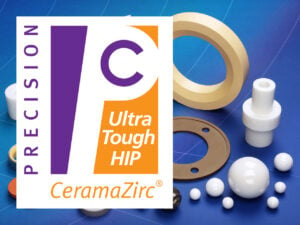
Zirconia
CeramaZirc Ultra Tough HIP
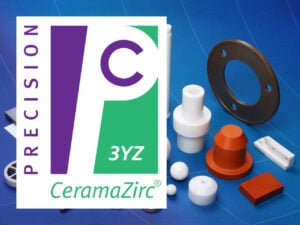
Zirconia
CeramaZirc 3YZ
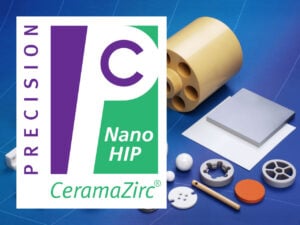
Zirconia
CeramaZirc Nano HIP
Zirconia Machining
In order to achieve very tight tolerances, the fully sintered material must be machined/ground with diamond tools. In this manufacturing process, a very precise diamond coated tool/wheel is used to abrade away the material until the desired form is created. Due to the inherent toughness and hardness of the material, this can be a time consuming and costly process.
Precision Ceramics is your Zirconia machining specialist for your advanced ceramic prototyping & manufacturing needs. We use our many years of technical ceramics experience to provide advice on materials, design, and application. If you would like to buy zirconia plates, rods, tubes or custom machined components, please contact us and one of our experts will be happy to assist you.
CeramaZirc Ultra Tough
CeramaZirc Ultra Tough is an advanced zirconia-based ceramic composite material based on partially stabilized zirconia and alumina platelets and is the latest and toughest composite to be introduced by Precision Ceramics.
Frequently Asked Questions
-
What can Zirconia ceramic be used for?
- Wire forming/drawing dies
- Insulating rings in thermal processes
- Precision shafts and axles in high wear environments
- Furnace process tubes
- Wear resistance pads
- Thermocouple protection tubes
- Sandblasting nozzles
- Refractory material
- Extrusion dies
- Bushings and caps
- Kiln furniture crucible
- Fiber optic ferrules and sleeves
- Knives and blades
- Fuel cell parts
- Bearings & rollers
- Welding nozzles & pins
- Laser parts
- Gas igniters
- Electric insulator
- Ceramic guiders
- Oxygen sensors
- Medical and surgical component
- Mechanical seals
- Pumps, pistons, and liners
-
What's the difference between Yttria and Magnesia Stabilized Zirconia?
While Y-PSZ is excellent for demanding mechanical applications, it may not be suitable for very high temperature applications because it suffers from grain boundary sliding; this occurs when prolonged exposure to heat causes the material to transform form the strong tetragonal phase to the weaker monoclinic phase. Similarly, it may not be suitable for warm and moist conditions since its properties deteriorate when it is exposed to water vapor. YSZ is therefore best suited when it is operating in dry and moderate temperature conditions. For more information on hydrothermal aging of Zirconia please contact us.
M-PSZ has better temperature and moisture resistant properties because it does not suffer from phase migration. M-PSZ maintains its strength even in moist high temperature environments where YSZ mechanical properties begin to deteriorate. -
What are the properties of Zirconia?
The following are some general properties of Zirconia ceramic. For a full list and comparison of Zirconia properties, see our Zirconia properties comparison table.
- High density – up to 6.1 g/cm^3
- High flexural strength and hardness
- Excellent fracture toughness – impact resistant
- High maximum use temperature
- Wear resistant
- Good frictional behavior
- Electrical insulator
- Low thermal conductivity – aprox. 10% of Alumina
- Corrosion resistance in acids and alkalis
- Modulus of elasticity similar to steel
- Coefficient of thermal expansion similar to iron
-
What is Zirconia ceramic?
Zirconia is a very strong technical ceramic with excellent properties in hardness, fracture toughness, and corrosion resistance; all without the most common property of ceramics – high brittleness. Unlike traditional ceramics that tend to be hard and brittle, Zirconia offers high strength, wear resistance, and flexibility far beyond those of most other technical ceramics.
There are several grades of Zirconia available, the most common of which are Yttria Partially Stabilized Zirconia (Y-PSZ) and Magnesia Partially Stabilized Zirconia (Mg-PSZ). Both of these materials offer excellent properties, however, the operating environment and part geometry will dictate which grade may be suitable for specific applications (more on this below). Its unique resistance to crack propagation and high thermal expansion make it an excellent material for joining ceramics with metals like steel. Due to Zirconia’s unique properties it is sometimes referred to as the “ceramic steel”. -
What's the difference between Zirconia, Alumina, and Zirconia Toughened Alumina (CeramAlloy)?
While Zirconia has the highest fracture toughness of all the oxide monolith ceramic materials, Alumina is one of the most cost effective ceramic materials yet exhibiting very high hardness, thermal stability and favourable electrical properties. CeramAlloy ZTA is a composite material based on Alumina and Zirconia and therefore combining to a certain extent the favourable properties of the two main constituents. So CeramAlloy ZTA will retain the very high hardness of Alumina but also show an increase in fracture toughness and bending strength owing to its Zirconia component so a true “best of both worlds”.



